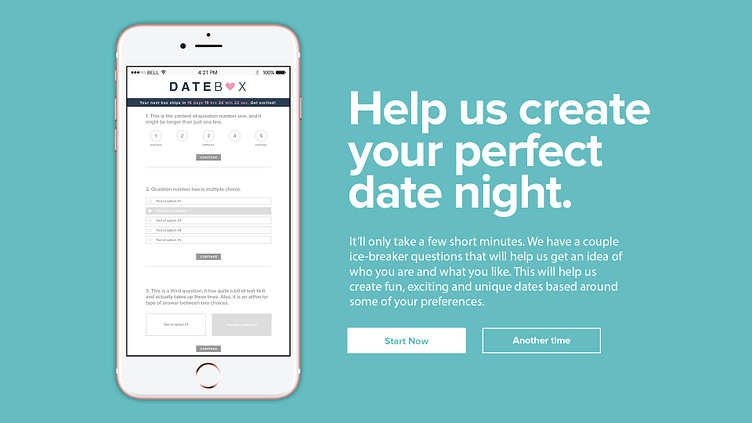Datebox Personalization
Product Feature, data, personalization, algorithm
The Problem
When we launched Datebox, retention and LTV were not strong. Product ratings and NPS were also low. More than 30% of users were churning after 1 month subscribing to the product.
We surveyed users, and also had hundreds of 1 on 1 conversations to find out why they were churning from subscriptions so quickly and why they rated their Datebox experience low. What we discovered was:
The most common answer to our question (73% of users surveyed) was that the date night we shipped to them, "wasn't something they were interested in" or "didn't fit their personalities and interests."
We realized that every couple is different, and their needs and interests are as unique as they are. Unless we personalized the date night experienced, we knew the business model would never be sustainable.
The Solution
We needed the ability to ship the perfect date night to each user, based on who they were as a couple.
We started by onboarding every user with a personalization quiz, to learn exactly what the couple liked to do, what their interests were, and what personality type they were:
Data: we gathered the following data to craft the perfect user experience:
Demographic - age, location, # of children, location
Relationship - dating, engaged, married, anniversary
Interests - users were shown a series of date concepts and asked to chose top three choices. Doing this allowed us to make inferences both on what they would enjoy, and what they wouldn't enjoy.
Personality - love language, communication style, what makes you two unique
Exclusion Needs - we needed to know what would absolutely ruin an experience for each user.
We created a queue in each users profile
All the answers from the users onboarding quiz would generate tags on the users profile. Each Datebox product also contained a set of tags in our system. We used these tags to match users interest, with characteristics that were true of the different date nights we offered. These tag matches told us what date night experience each user would get, in order, if there were no other factors to consider. We created a queue in descending order based on the number of tag matches a couple had with each product. This queue was the fully optimized, ideal experience for each user in our system.
We then use the data and user queues, to create a product assignment algorithm
This algorithm assigned monthly Datebox experiences to each user simultaneously while optimizing for:
User satisfaction: what date is highest in their queue
Inventory: we can only assign boxes we have in stock
Product History: a user can only receive each box one time
Retention History: prioritize users who have been with us longer
Community Ratings: which date experiences have the highest community rating if other factors aren't distinctive enough to make a product assignment decision
LTV: Product cadences that led to the highest LTV for other users with similar answers to their quiz










